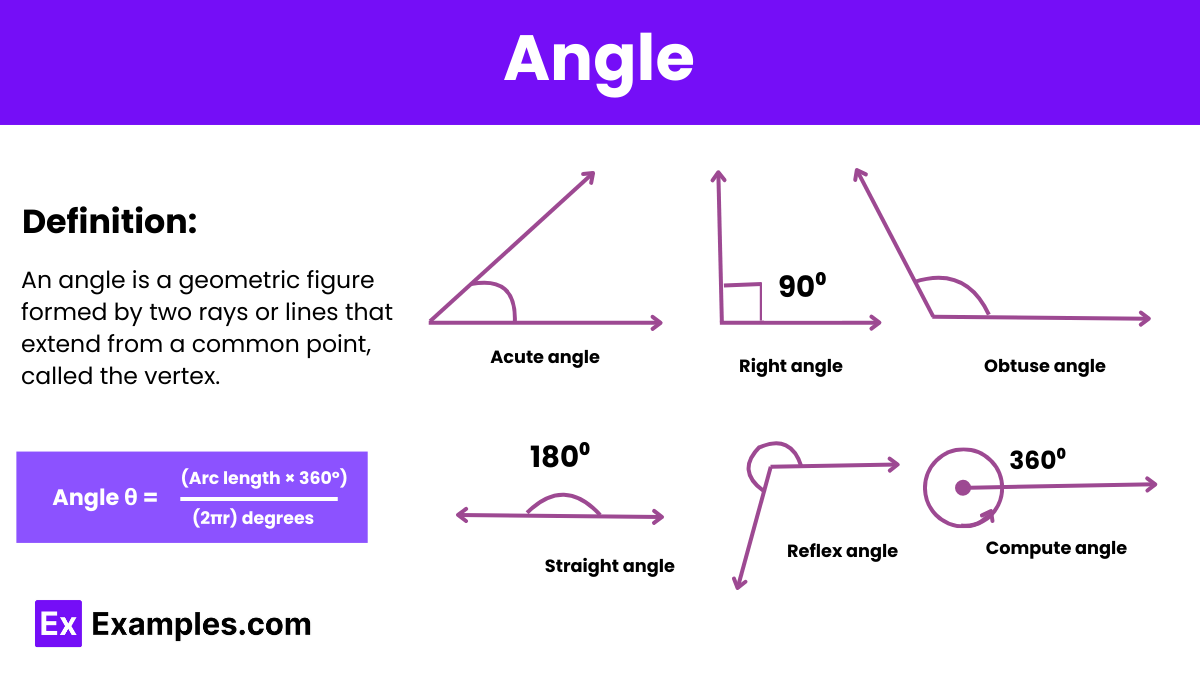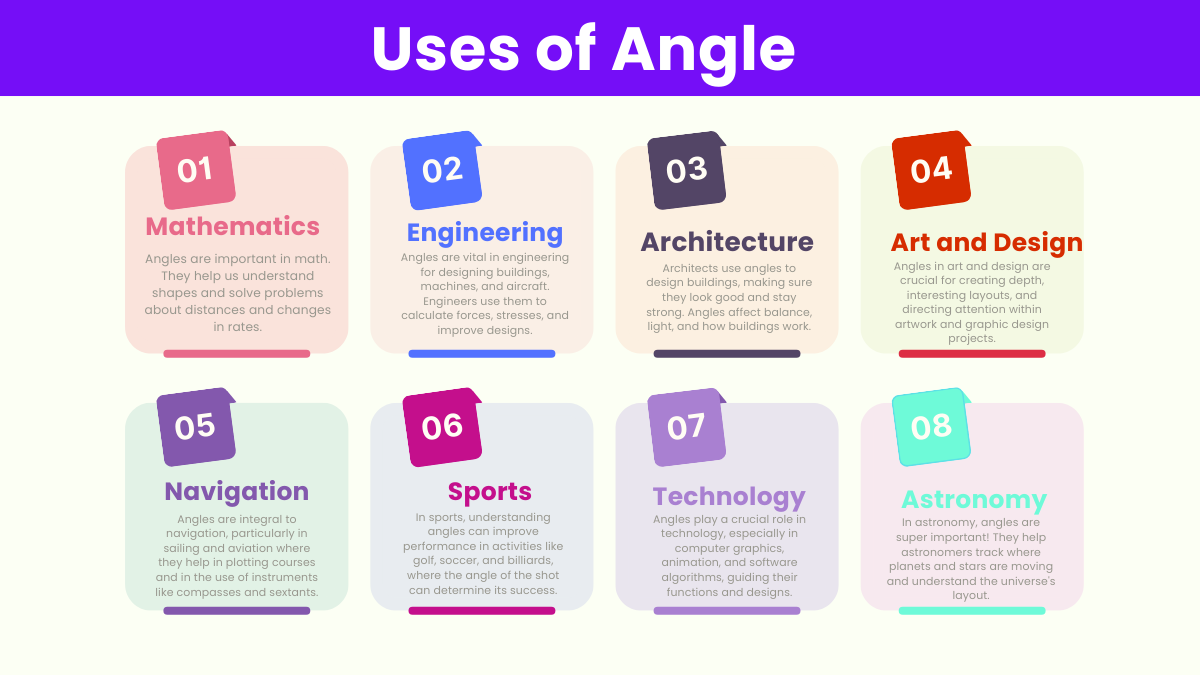What is the sum of the interior angles of a triangle?
180 degrees
360 degrees
90 degrees
270 degrees


an Angle is a measure of the rotation or separation between two intersecting lines or surfaces at their point of intersection. It quantifies the degree of rotation necessary to align one line or surface with another and is typically measured in degrees or radians. Angles are fundamental in describing rotational motions, orientations, and various geometrical configurations.
Angular Displacement in Circular Motion
Angular displacement θ (in radians) can be calculated if you know the arc length s and the radius r of the circle
Snell’s Law (Refraction)
When light passes from one medium to another, the angle of incidence θᵢ and the angle of refraction θᵣ are related by
Where n₁ and n₂ are the refractive indices of the two media.
Law of Reflection
The angle of incidence θᵢ is equal to the angle of reflection θᵣ
Using Torque in Rotational Dynamics
Torque (τ) is related to the force applied (F), the distance from the point of rotation (r), and the angle θ between the force vector and the lever arm vector
The force F on a charged particle moving in a magnetic field is perpendicular to the direction of the velocity v and the magnetic field B, and can be calculated as
Where q is the charge of the particle, v is the velocity, B is the magnetic field strength, and
θ is the angle between v and B.
| Multiple/Submultiple | Name | Symbol | Equivalent in Degrees | Equivalent in Radians |
|---|---|---|---|---|
| Submultiples | ||||
| Milliradian | Milliradian | mrad | Approx. 0.0573° | 0.001 rad |
| Microradian | Microradian | µrad | Approx. 0.0000573° | 0.000001 rad |
| Degree | Degree | deg | 1° | π/180 rad |
| Minute of arc | Minute | arcmin | 1/60° | π/10800 rad |
| Second of arc | Second | arcsec | 1/3600° | π/648000 rad |
| Multiples | ||||
| Radian | Radian | rad | 57.2958° | 1 rad |
| Revolution (Turn) | Revolution | rev | 360° | 2π rad |

A zero angle occurs when the two arms of the angle overlap completely, essentially creating a straight line with no visible separation between the arms. It measures 0 degrees and is often used as a starting point in angle measurement.
A 180-degree angle is commonly referred to as a straight angle. It looks like a straight line and represents a half rotation from one point back to itself, dividing the plane into two equal parts.
When considering a clock face as a circle divided into 360 degrees, each hour represents 30 degrees of rotation from 12 o’clock. Therefore, 3 o’clock corresponds to 90 degrees from the top of the clock (12 o’clock).
In trigonometry, an angle is typically defined in terms of rotation from a standard initial side (usually the positive x-axis) within a Cartesian coordinate system. It is used to explore the relationships between the angles and sides of triangles. Trigonometric functions like sine, cosine, and tangent are based on angles and are fundamental in calculating various properties and solving problems involving triangles and other geometric figures.
Text prompt
Add Tone
10 Examples of Public speaking
20 Examples of Gas lighting
What is the sum of the interior angles of a triangle?
180 degrees
360 degrees
90 degrees
270 degrees
If two angles in a triangle are 40 degrees and 60 degrees, what is the measure of the third angle?
80 degrees
100 degrees
120 degrees
90 degrees
In a right triangle, one angle is 90 degrees. What is the sum of the other two angles?
90 degrees
180 degrees
270 degrees
360 degrees
What type of angle is greater than 90 degrees but less than 180 degrees?
Acute angle
Right angle
Obtuse angle
Reflex angle
Which of the following angles is exactly 90 degrees?
Acute angle
Right angle
Obtuse angle
Reflex angle
If two angles are supplementary, what is their sum?
90 degrees
180 degrees
270 degrees
360 degrees
Which of the following is true about complementary angles?
Their sum is 180 degrees
Their sum is 90 degrees
Each angle is greater than 90 degrees
Their sum is 360 degrees
What do you call angles that are opposite each other when two lines intersect?
Complementary angles
Supplementary angles
Adjacent angles
Vertical angles
What type of triangle has all angles equal?
Scalene triangle
Isosceles triangle
Equilateral triangle
Right triangle
What is the measure of each interior angle in a regular hexagon?
90 degrees
120 degrees
135 degrees
150 degrees
Before you leave, take our quick quiz to enhance your learning!

